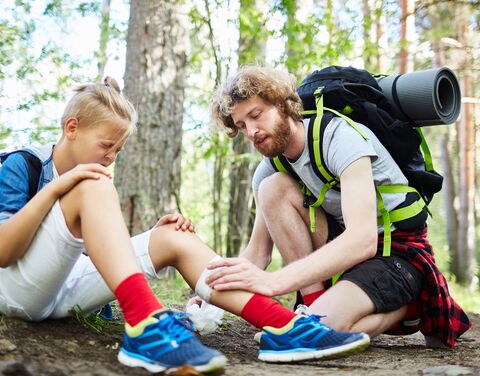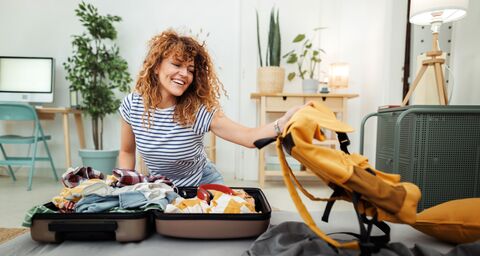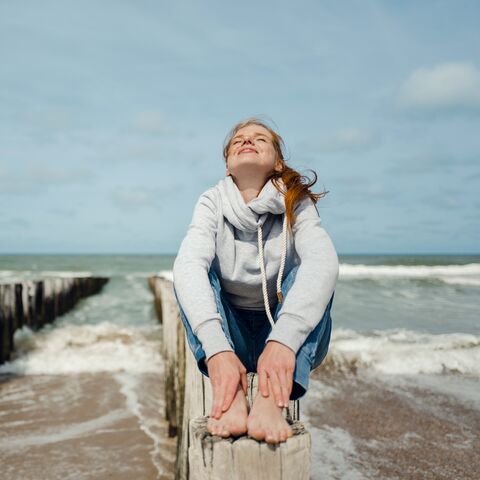
First-aid kit: well equipped for a worry-free vacation
Vacations should primarily be a time of rest, relaxation and happy moments. Nevertheless, something can always happen, including when it comes to health. That’s why it’s helpful to have a well-equipped first-aid kit with you.
Whether you have a cold, minor injuries, an upset stomach, allergies or a sudden sunburn: such problems can quickly spoil your holiday mood. However, with the right preparation, they can often be prevented or treated quickly. In our guide, you’ll find out what should be in your first-aid kit and how best to prepare a medication bag for your trip.
First-aid kit checklist: fit and healthy for your vacation
A well-equipped first-aid kit is important, as it enables you to deal with health problems on your travels. Whether you’re traveling to warm or cooler regions, the right preparation can help you solve minor health problems yourself and avoid unnecessary trips to the pharmacy or even the doctor. You should always take the following items and medication with you, regardless of your destination.
Basic equipment:
- Pain and fever medication
Medication such as paracetamol or ibuprofen should always be to hand when traveling to relieve pain and fever . This can be particularly helpful on long flights or hikes. - Plasters and sterile dressings
Patches of different sizes help to treat cuts, abrasions or blisters quickly and hygienically. - Antiseptic
This protects against infection by keeping wounds germ-free. In regions with limited sanitation, a disinfectant can also be useful for hands or surfaces. - Clinical thermometer
If you have a high temperature, you can measure it accurately to find out if you have a fever. - Tweezers
Tweezers are useful to safely remove splinters, thorns or even a sting after an insect bite.
Medication against specific ailments:
- Travel sickness
Products such as dimenhydrinate help combat motion sickness such as nausea when traveling by car, boat or air. - Diarrhea
Loperamide, for examples, eases acute diarrhea and is particularly useful for long journeys. - Ointments
Ointments for skin irritation, whether caused by sunburn, minor burns or itching after an insect bite, should also be included in your first-aid kit. - Electrolyte drinks
Compensate for fluid and electrolyte loss inf you have diarrhea. - Personal medication
If you take regular medication, you should make sure you have enough with you. Remember to have these medications handy at all times.
Protection against environmental factors:
- Sun cream
Protect your skin from harmful UV radiation and sunburn, especially in sunny holiday destinations. The sun protection factor (SPF) depends on your skin type, but also on the intensity of the UV rays, which can vary greatly depending on the holiday destination. The effect is much stronger at higher altitudes and around midday in particular. It is best to avoid being in the sun at lunchtime altogether and apply the sunscreen several times a day. - Insect repellent
Avoid insect bites, primarily in high-risk areas with insect-borne diseases. Long-sleeved shirts and long trousers also offer a certain level of protection. - Eye drops
These are useful if dry air conditioning, dust or wind irritate the eyes. They can also be beneficial for mild allergic reactions.
Don’t forget about your vaccinations
Depending on the destination, certain vaccinations may be required or recommended to protect against diseases such as hepatitis, typhoid or yellow fever. Especially in tropical or rural areas with an increased risk of infection, you should inform yourself well before departure. A look at your vaccination history and a consultation at your pharmacy or general practitioner will help you plan the right coverage for your trip. Remember that some vaccinations must be given several weeks before departure to ensure optimal protection.
First-aid kit for special groups and special needs
When packing medication for your trip, you should also take into account the specific needs of certain groups. These groups include pregnant women: The first-aid kit should always contain a remedy for nausea and magnesium supplements to treat leg cramps and constipation.
For older travelers, it is advisable to pack enough medication for existing pain or chronic illnesses, as well as medicines to regulate blood pressure.
Even with children, the first-aid kit must contain certain medicines. It should always contain fever and painkillers in an appropriate dosage and form (juice or suppositories). Other preparations in your first-aid kit should not just be suitable for adults. For example, choose a particularly high-factor sun cream that protects sensitive children's skin against sunburn.
How to store medicines in your first-aid kit
To ensure that your medicines are effective and safe when you travel, they must be stored correctly. Here are some tips:
- Protect medicines against the heat and direct sunlight
You should store medicines in a cool and dark place. Direct sun rays and high temperatures can be harmful. Do not leave your first-aid kit in the car or directly on the beach in the sun. - Avoid humidity and wet conditions of any kind
Store medicines in a watertight medicine bag or an easily sealable container to protect them from humidity. Humidity can have a negative effect on the properties of medicines and reduce their efficacy. - Store medicines in their original packaging
It's best to store medicines in their original packaging wherever possible, including the instruction leaflet. This facilitates identification and dosage, and information on side effects and shelf life is available at all times. If you can no longer find the original packaging, check the internet or your pharmacy to find out how to take them correctly. - Carry important medicines in your hand luggage
If you're flying, it's advisable to store important medicines in your hand luggage. This means you have important medication to hand, particularly if your main luggage gets lost. When doing so, observe the safety regulations for transporting liquids and sharp objects. - Keep medicines out of the reach of children
Some medicines pose a health risk to children, so you should ensure that travel medication is not accessible to children. Containers with child-resistant closures are the most suitable . - Check the shelf life and use-by date
Before you travel, you should check the use-by date of all medicines in your first-aid kit and exchange any expired ones. This ensures that you have effective medicines with you. - Change the storage when you reach your destination
Consider the climatic conditions at your destination when storing your medication. In tropical areas in particular, you may have to take additional measures to combat the humidity.
Consult a pharmacy
It’s worth stopping by a pharmacy before your vacation: The specialist staff will not only offer you individual advice on how best to put together your first-aid kit, but also advise you about important preventative measures, and how to use the medicines correctly. You can get vaccinated directly at the pharmacy and start your vacation well prepared.






